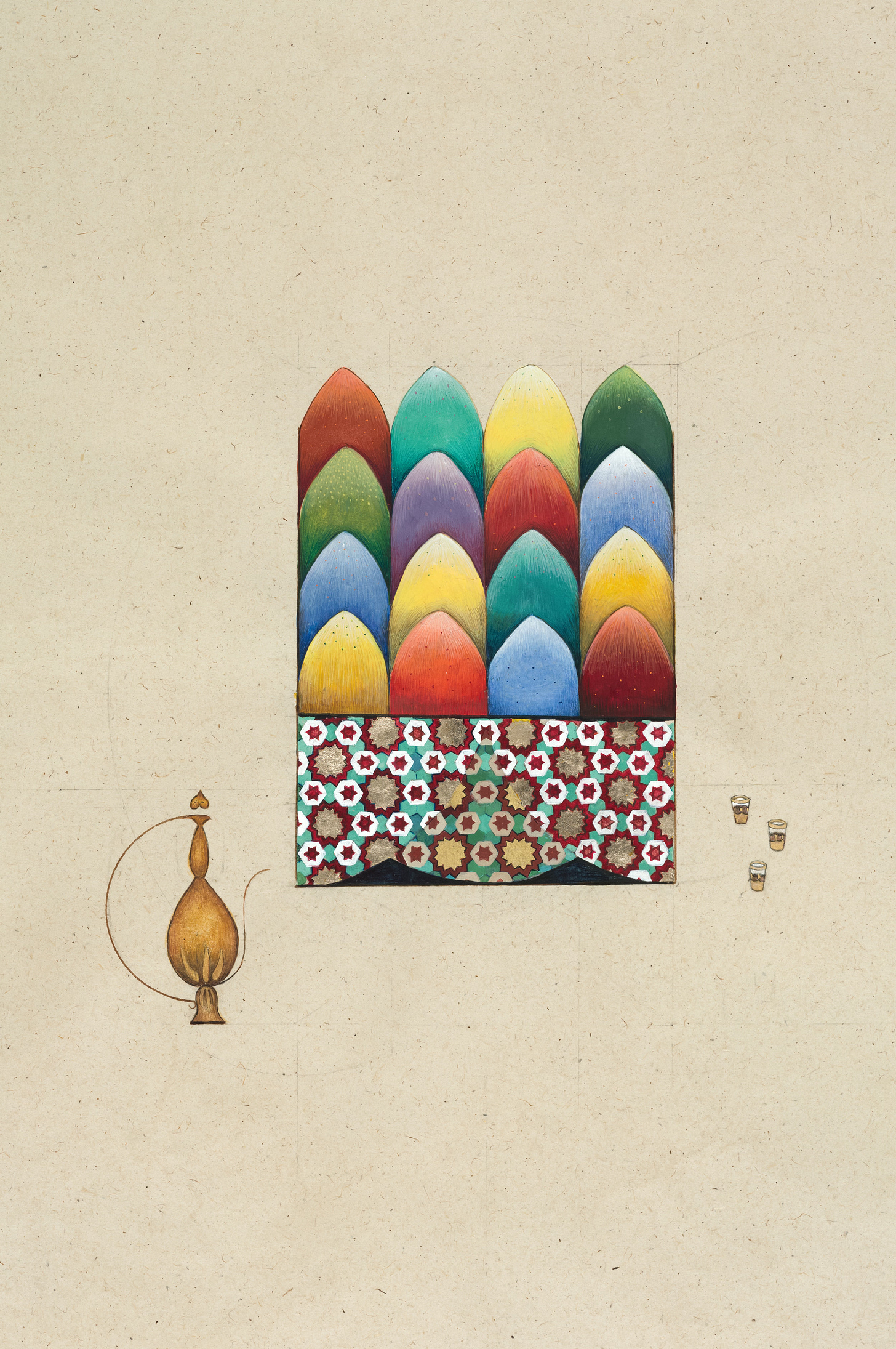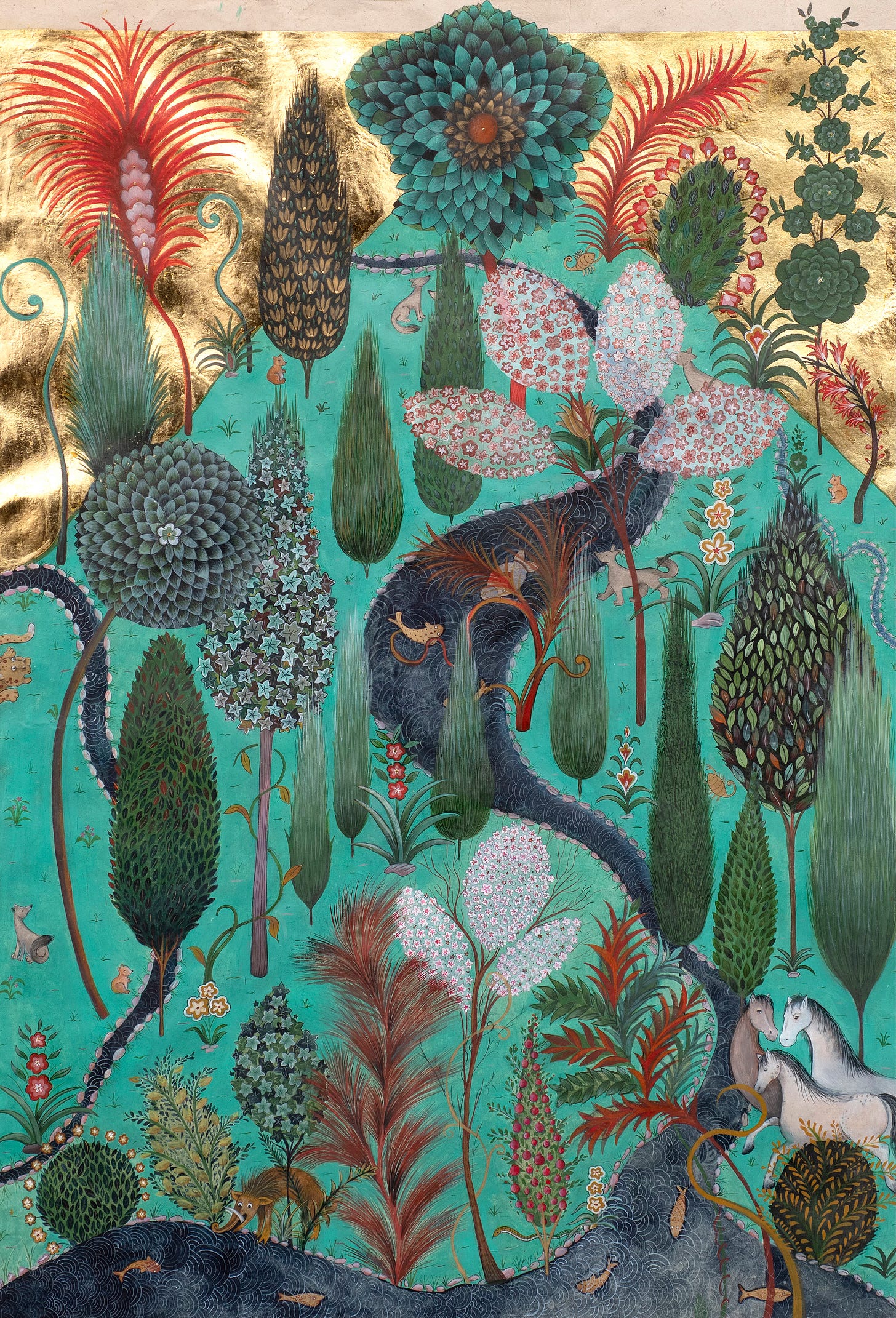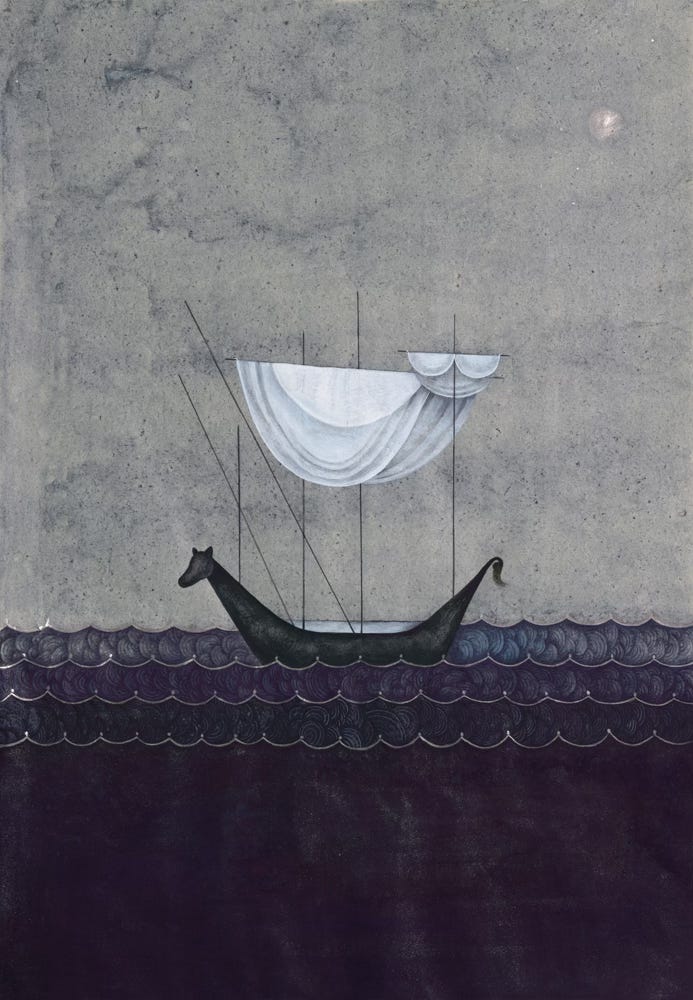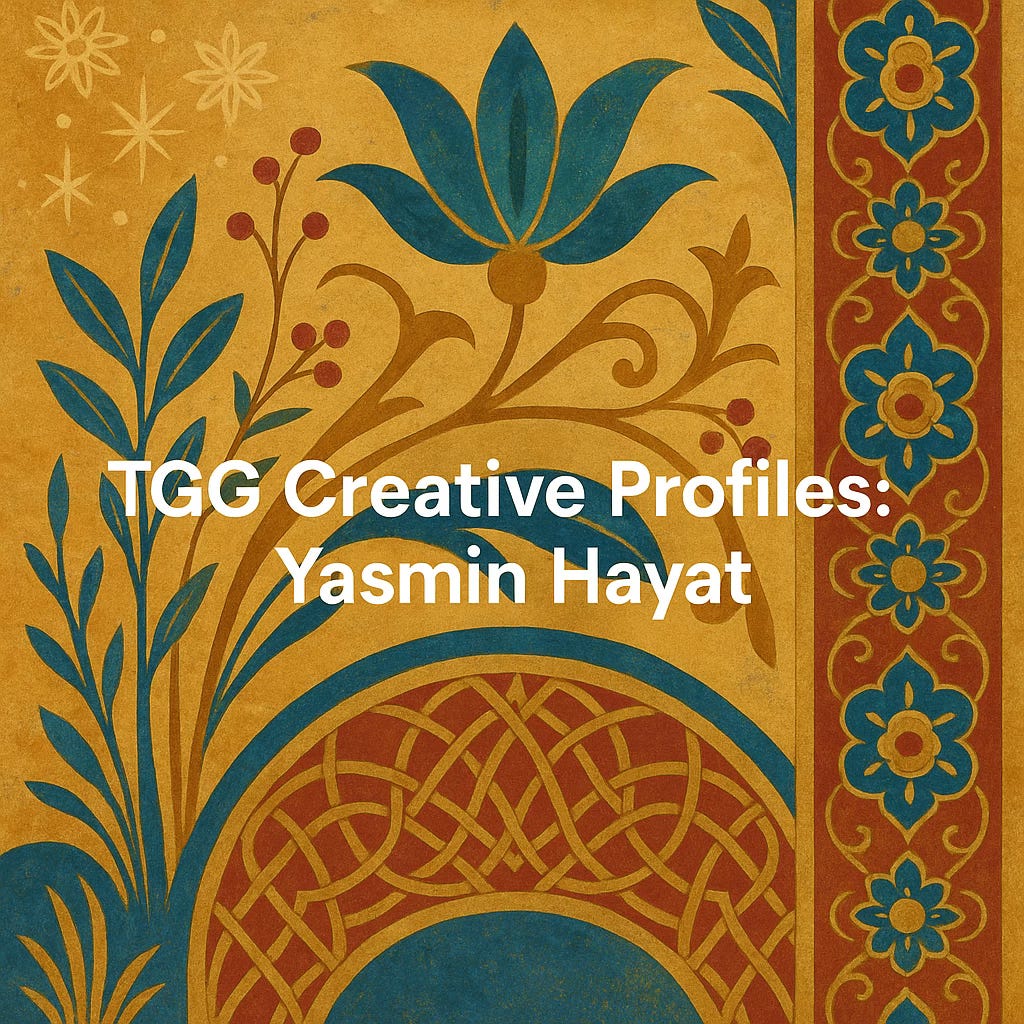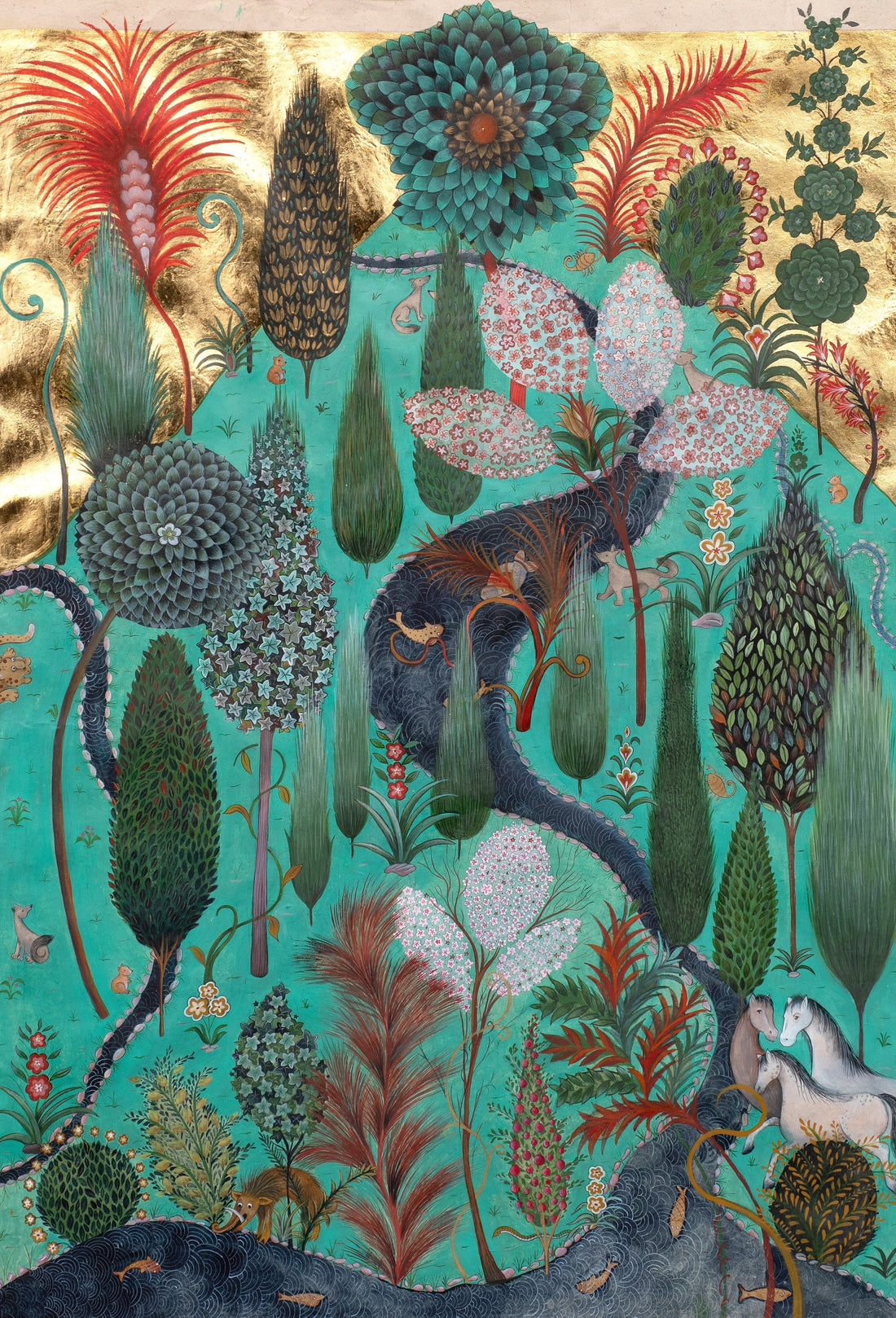
Share
The Geometry of Memory: Yasmin Hayat’s Journey Home
In every curve and colour, a search for belonging, beauty, and the threads that bind us to the past.
Editor's Note
Welcome to the first edition of Creative Profiles — a new series in The Ghannouj Gazette that celebrates artists whose work weaves together heritage, memory, and imagination.
Through intimate conversations, we'll explore how identity shapes creativity, tradition dances with reinvention, and personal histories echo in the works they create.
It feels only fitting to open this series with Yasmin Hayat, a British-Syrian artist whose paintings capture the spirit of stories, landscapes, and emotions in a way that is truly captivating. Yasmin's journey is one of resilience, reverence, and reimagination — a perfect first step into the vibrant world of Creative Profiles.
A Dance Between Silence and Spice
Growing up between the cool hush of an English coastal town and Damascus's golden, humming streets, Yasmin Hayat learned early that life could stretch between two very different worlds—and still feel whole.
"Damascus is a feast for the senses," she says, recalling the first breath one takes upon landing: dry, heavy heat tangled with gasoline. Bournemouth, by contrast, is salt spray and wildflower air. "One is light, and the other is heavy." Yasmin carries a duality into her art: the calm and the chaos, the retreat and the revelry. In Bournemouth, she found solitude, a rhythm of long walks that stirred ideas to life. In Damascus, she found the sensual pulse of storytelling, the hum of life right against the walls.
The interplay of these landscapes laid the foundation for her creative practice, a visual language deeply rooted in memory, tradition, and storytelling. "Bournemouth allowed me to realise the scene within my mind's eye," she reflects, "whilst Damascus is the actor performing the main scene." Today, living in London—a city she calls "a melting pot where anything goes"—Yasmin feels most at home precisely because she doesn't have to choose between her British and Syrian identities. She can simply exist.
Belonging, Otherness, and Finding a Voice
Childhood in coastal England was not without its sharp edges. Growing up with an Arab father, Yasmin remembers the sting of xenophobic slurs, the quiet but persistent reminders that she was seen as 'other.' These experiences, though painful, became the raw material for her art, shaping her personal identity and the soul of her work.
Yet, in Syria, she was wrapped in a sense of belonging. That early experience of simultaneous embrace and rejection has shaped not just her personal identity but the soul of her art. "My experience, layered on top of the political situation and the unfolding of the Arab Spring, is what ultimately drove me to make the art that I do," she says. Yasmin's paintings, steeped in Middle Eastern stories, smells, music, and poetry, aim to challenge the flattened, often fearful narratives surrounding her heritage—and offer instead a vibrant, textured counterpoint.
Central Saint Martins: A Pivotal Tug-of-War
When Yasmin received an unconditional offer from Central Saint Martins, it felt like destiny. But inside the institution's revered walls, she was caught in an exhausting tug-of-war between contemporary trends and her desire to explore traditional techniques.
'I was caught between trying to be what I believed a successful artist in London should be and filling this insatiable desire to explore the methodology that informed my identity.' This desire, a hunger to connect with her roots and express her unique perspective, ultimately led her to a deeper understanding of her art.
But that painful rupture paved the way for discovery. Freed from the pressure to perform, Yasmin pursued traditional geometry, marquetry, and manuscript painting with a scholarly and deeply personal passion. She ultimately found her way to the Prince's School of Traditional Arts, where she could fully immerse herself in the philosophies and techniques of the SWANA (South West Asia and North Africa) region.
Apprenticeships in Patience and Preservation
Traditional craftsmanship, Yasmin explains, demands humility. Historically, miniature painting was a collaborative act—artists specialised separately in faces, goldwork, and borders, each contributing their mastery.
Learning these disciplines today requires a return to old ways: slow transmission from teacher to student, a hand-to-hand lineage almost impossible to replicate digitally. "If you rush, it simply falls apart," she says.
She recounts a miniature painting course in which, after five eight-hour days, her work cracked clean off the paper—all because she skipped one step in checking pigments. "I cried," she admits. But that was the moment she fell in love with the art form. Today, her process feels like meditation: a binding of hand, heart, and mind.
Painting as a Time Capsule
Geometry forms the silent skeleton of Yasmin's work. Beneath each curve and colour is a structure older than empires—a proportional, universal rhythm. Symbols weave across her paintings like echoes from a thousand years ago.
"I try to remove as much of myself as possible from my paintings," she says. "When the work becomes indulgent, the story becomes lost." Instead, Yasmin becomes a vessel: the celebrator of ancient stories, not their rewriter.
Her inspirations are varied and rich: medieval manuscripts from the Levant, the cosmological whale Bahamoot from The Thousand and One Nights, and contemporary Syrian voices like poet Ghayath Almadhoun. Her paintings strive to capture the same magic as a hakawati—the storyteller of old Damascus coffee shops—whose tales would unfurl like smoke into the night.
Nostalgia and the Shifting Light
The 2011 uprising and subsequent destruction of Syrian cities transformed Yasmin's relationship with memory. What began as an intellectual fascination with Middle Eastern patterns deepened into a fierce longing to preserve and protect cultural fragments.
Over time, as her memories of Syria blurred and softened, her work grew more romantic and wistful. "My memories are fond and blurry, details slipping," she says. Now, the work is about longing, drifting—and an aching pain. And now, hope—real hope and excitement."
Feeding the Flame
When feeling adrift, Yasmin turns to words, hikes, and learning. "Hiking clears my head," she says. The slow rhythm helps me visualise paintings from words." She makes courses a regular part of her life, refreshing her skills and guarding against creative stagnation.
Her inspirations today span the searing poems of Ghayath Almadhoun to the tender darkness of Nihad Sirees's novels. Even reaching the summit of Mount Kilimanjaro—painted in soft blues and pinks against the vast sky—felt like a moment of pure, transformational wonder.
The Music of Her Studio
To enter Yasmin's world is to step into a studio pulsing with the soft beats of Tulum and the haunting strings of Andre Soueid. Here's a peek into her brushstroke playlist:
-
Wahem – Andre Soueid
-
Fervor of Love – Massoud Shaari x Christopher Rezai
-
Mama Eh – Elyanna
-
Tulum - Epico – PAXX
-
Fix Yourself – Placebo
-
The Date – Whilk & Misky
-
Escalate (Live at Les Diners De Gala) – Tsar B
-
The Journey – Massoud Shaari x Christopher Rezai
-
Ritual Spirit – Massive Attack
-
Feathered Sun – Bulbo
In her studio, time bends. Stories and smells, long-forgotten songs and ancient geometries blend until past and present are no longer strangers. In Yasmin Hayat's hands, art becomes a living memory—a celebration, a meditation, and, above all, a love letter to the spirit of a world she refuses to let fade.

